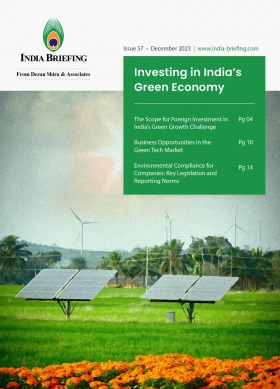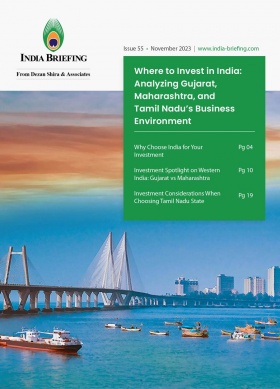Mumbai Investment Profile: Economy, Infrastructure, Industries
Mumbai, formerly known as Bombay, is the capital city of the western state of Maharashtra. 
The Greater Mumbai area occupies a long, narrow peninsula in the Arabian Sea on the west coast of India. Mumbai City is an island of 69 square kilometers and also referred to as “Old Mumbai” or “South Mumbai”.
Mumbai ranks among the world’s top five cities in terms of population, including its metropolitan region known as the Mumbai Metropolitan Region (MMR), which is estimated to have exceeded 20 million.
The MMR region spans 6,328 sq.km., covering Greater Mumbai, Thane, Kalyan-Dombivali, Navi Mumbai, Ulhasnagar, Bhiwandi-Nizamapur, Vasai-Virar, Mira-Bhayandar, and Panvel. Additionally, it includes nine Municipal Councils: Ambarnath, Kulgaon-Badalapur, Matheran, Karjat, Khopoli, Pen, Uran, Alibaug, and Palghar, along with over 1,000 villages across Thane, Raigad, and Palghar Districts.
Mumbai city profile and economy
Mumbai is the largest city in Maharashtra and is the top financial and commercial hub of India, given its significant contribution to the nation’s economy.
Source: Planning Department, State Government of Maharashtra
Mumbai boasts a Gross Domestic Product (GDP) of US$140 billion, per the Niti Aayog. To put things into perspective, the state of Maharashtra’s Gross State Domestic Product (GSDP) was approximately US$435 billion in 2022-23, accounting for 12.92 percent of India’s GDP.
The economy of Mumbai relies heavily on the banking, insurance, and financial services sector, consumer packaged goods, port-based trade, IT services, and the Bollywood film industry. Further, Mumbai hosts all major financial institutions, banks, and stock exchanges and houses the headquarters or administrative offices of most leading Indian companies, conglomerates, and multinational entities.
The climate of Mumbai is a mix of tropical wet and dry climate, with a lengthy, dry season and a relatively short, but extremely rainy wet season.
Mumbai holds the distinction of being the most densely populated metropolitan region globally, with over 50,000 individuals per square kilometer, surpassing Delhi’s 29,000 and Shanghai’s 28,000. Additionally, it ranks as one of the costliest cities in India.
Foreign investment
In FY 2022-23, the state of Maharashtra pipped Karnataka and Gujarat to be the top foreign direct investment (FDI) destination. Given its outsize contribution to the state’s economy, a significant portion of that foreign investment is likely to have been directed to Mumbai.
Between October 2019 and September 2023, Maharashtra attracted US$61.92 billion in FDI (equity inflow, equity capital of unincorporated bodies, re-invested earnings, and other capital).
Infrastructure
Until recently, Mumbai faced challenges stemming from inadequate infrastructure, particularly affecting connectivity, and congestion. However, the city is now making substantial investments worth about US$30 billion in a variety of projects aimed at enhancing its infrastructure to align more closely with that of other global cities.
Key connectivity projects
Major new and upcoming infrastructure projects in the Mumbai Metropolitan Region are the Mumbai Trans Harbour Link; the establishment of a new city – referred to as ‘Third Mumbai’; the Navi Mumbai International Airport – which is a greenfield airport and projected to accommodate annual traffic of 20 million passengers in its initial phase; the Mumbai Coastal Road Project – along the western seafront; and the Aqua Line 3 of the Mumbai Metro Network – whose route covers the Colaba-Bandra-SEEPZ ((Santacruz Electronics Export Processing Zone) corridor and will establish connectivity between Mumbai city’s main financial centers of Nariman Point, Bandra-Kurla-Complex, Fort, Worli, Lower Parel, and Goregaon.
Public transportation
The city is mainly served by the Mumbai Suburban Railway consisting of three separate railway networks: the Central, Western, and Harbor Line. Mumbai is also building a metro rail network with a proposed length of 337 km, out of which 46.5 km is operational while the rest is in different phases of construction. Finally, the city boasts of India’s first monorail system that launched its Phase 1 in July 2014.
|
Mumbai Metro |
||||
|
Metro Line |
Terminal/Corridor |
Length (KM) |
Station |
Status |
|
Line – 1 |
Verova – Andheri – Ghatkopar |
11.4 |
12 |
Operational |
|
Line – 2A |
Dahisar (East) – DN Nagar |
18.60 |
17 |
Operational |
|
Line – 2B |
DN Nagar – Mandale |
23.64 |
22 |
Under construction |
|
Line – 3 |
Cuffe Parade – BKC – Seepz – Aarey Colony |
33.50 |
27 |
Under construction |
|
Line – 4 |
Wadala – Kasarawadavali |
32.32 |
32 |
Under construction |
|
Line – 4A |
Kasarawadavali – Gaimukh |
2.88 |
2 |
Under construction |
|
Line – 5 |
Thane – Bhiwandi – Kalyan |
24.95 |
17 |
12.811 km Under Construction; Rest On-Hold |
|
Line – 6 |
Swami Samarth Nagar – Vikhroli |
15.18 |
13 |
Under Construction |
|
Line – 7 |
Dahisar (East) – Andheri (East) |
16.5 |
14 |
Operational |
|
Line – 7A |
Andheri (East) – Chhatrapati Shivaji International Airport (extn of Line-7) |
3.17 |
2 |
Under Construction |
|
Line – 8 |
Chhatrapati Shivaji International Airport – Navi Mumbai international Airport |
35 |
7 |
Proposed |
|
Line – 9 |
Dahisar (East) – Mira Bhayander |
11.38 |
8 |
Under Construction |
|
Line – 10 |
Gaimukh – Shivaji Chowk in Mira Road |
9.20 |
4 |
Approved |
|
Line – 11 |
Wadala – Chhattrapati Shivaji Maharaj Terminus (extn of Line-4) |
12.77 |
10 |
Proposed |
|
Line – 12 |
Kalyan – Taloja (extn of Line-5) |
20.7 |
17 |
Proposed |
|
Line – 13 |
Shivaji Chowk (Mira Road) – Virar |
23 |
20 |
Proposed |
|
Line – 14 |
Kanjurmarg – Badlapur |
45 |
40 |
Proposed |
Air
Presently, the city is serviced only by the Chhatrapati Shivaji International Airport, managing a remarkable 51.58 million passengers in 2023. To address congestion concerns at Mumbai’s sole airport, an additional airport is under construction in Navi Mumbai as mentioned earlier. Anticipated to commence commercial operations by December 2024, the initial capacity is set at 20 million passengers annually, with the potential for expansion to accommodate up to 90 million passengers and 2.5 million tonnes of cargo per year by 2032.
Roads
Mumbai enjoys connectivity through National Highways 3, 4, 8, 17, and 222, with additional access to Pune via a comprehensive road system, notably the six-lane Mumbai-Pune Expressway. Concurrently, ongoing construction aims to establish expressways connecting Mumbai with Nagpur and national capital Delhi.
The Bandra-Worli Sea Link Bridge, in conjunction with the Mahim Causeway, connects Mumbai’s island city to the western suburbs. Additionally, the recently opened Mumbai Trans Harbour Link (MTHL) and Vashi Bridge provide connectivity to Navi Mumbai.
The government is currently undertaking a series of new projects aimed at enhancing mobility within the city and boosting traffic flow speeds.
|
Key road project |
Purpose |
|
Coastal Road |
Connecting Marine Drive to Dahisar in 3 sections |
|
Thane – Borivali Link Road |
Running under Sanjay Gandhi National Park, connecting eastern and western suburbs |
|
Orange Gate – Marine Drive Tunnel |
Connecting Eastern Freeway to Coastal Road |
|
Goregaon – Mulund Link Road |
Connecting east and west highways |
|
Dahisar To Bhayandar Flyover |
Connecting north and west suburbs |
|
Worli – Sewri Connector |
Connecting MTHL to Bandra-Worli Sea Link |
|
NCPA – Cuffe Parade Bridge |
Connecting south tip to Coastal Road
|
Port
Mumbai Port Trust and Jawaharlal Nehru Port Trust (JNPT) are India’s two primary ports, collectively offering the most extensive port facilities in the country. Together, they manage over a third of India’s total foreign trade. In the financial year 2022-23, Mumbai Port Trust achieved a historic milestone by handling 63.61 million metric tonnes of cargo, marking a 6.21 percent rise from the preceding year and surpassing the previous record set in 2016-17.
Major industries in Mumbai
According to Henley and Partners, Mumbai, recognized as India’s financial center, accommodates roughly 59,400 individuals with a net worth exceeding US$1 million, placing it among the globe’s most affluent cities. Furthermore, its GDP exceeding US$100 billion forms a major portion of Maharashtra’s economic output. The government wants to increase this output to over US$300 billion by 2030.
Finance
Mumbai stands as one of the leading global hubs for commerce, particularly in terms of financial flows. It houses significant institutions such as the National Stock Exchange (NSE), ranked as the world’s 7th largest stock exchange, alongside the Bombay Stock Exchange, the Reserve Bank of India, and Securities and Exchange Board of India (SEBI).
Entertainment
Mumbai is the base of Bollywood, the Hindi language movie industry. The city has also become one of the most vibrant creative arts centers in India and plays host to a number of national and international events, including sports, related events, conferences, and seminars.
Research centers
Some of the leading Indian research institutions in Mumbai include the Bhabha Atomic Resarch Center, the Tata Institute of Fundamental Research, the National Chemical Laboratory, the National Center for Cell Science, the National Institute of Virology, the National AIDS Research Institute, and the National Environmental Engineering Research Institute.
Tourism
Mumbai’s cosmopolitan culture and heritage sites provides tourists with a rich itinerary. Religious sites like the Mumbai Devi Temple, Siddhivinayak Temple, Haji Ali Mosque, Mt Mary’s Church, and others also attract large numbers of domestic tourists. Additionally, the city boasts numerous historical landmarks, such as the Gateway of India, Elephanta Caves, and Kanheri Caves.
Real estate
The Mumbai real estate sector has long been lively and dynamic in India, propelled by various factors. Given the ongoing economic revival and increasing demand for both residential and commercial properties, the momentum in Mumbai’s real estate trends is anticipated to persist throughout the coming years.
In 2024, the Mumbai real estate market is poised to sustain its growth due to several key factors:
- Population growth: Mumbai’s population has been steadily increasing, driving demand for residential apartments. Developers are responding by initiating new projects to meet this rising demand.
- Financial hub status: Mumbai’s position as India’s financial capital continues to attract businesses and professionals, thereby fueling demand for commercial properties.
- Affordable housing initiatives: Government initiatives aimed at promoting affordable housing include subsidies, incentives for developers, and land cost reductions. These measures facilitate the construction of affordable housing projects, benefiting low and middle-income families.
- Infrastructure development: Authorities are undertaking various infrastructure projects to enhance the city’s connectivity. These initiatives, including the construction of highways and metro lines, improve accessibility, and stimulate development in new areas.
- Corporate growth: The corporate sector in Mumbai is expanding rapidly, with major companies establishing offices in the city. This surge in business activity drives demand for commercial real estate, particularly in areas like Bandra and Andheri.
- Foreign investment: Mumbai continues to attract foreign investment in its real estate sector, underscoring its appeal to investors. Forecasts suggest that this trend will persist in 2024, further bolstering the city’s real estate market.
About Us
India Briefing is produced by Dezan Shira & Associates. The firm assists foreign investors throughout Asia from offices across the world, including in Delhi and Mumbai. Readers may write to india@dezshira.com for more support on doing business in India.
We also maintain offices or have alliance partners assisting foreign investors in Indonesia, Singapore, Vietnam, Philippines, Malaysia, Thailand, Bangladesh, Italy, Germany, and the United States.
- Previous Article A Step-by-Step Guide to Establishing Your Business in India’s GIFT City
- Next Article Farm Mechanization in India’s Agriculture Sector: Challenges and Opportunities








